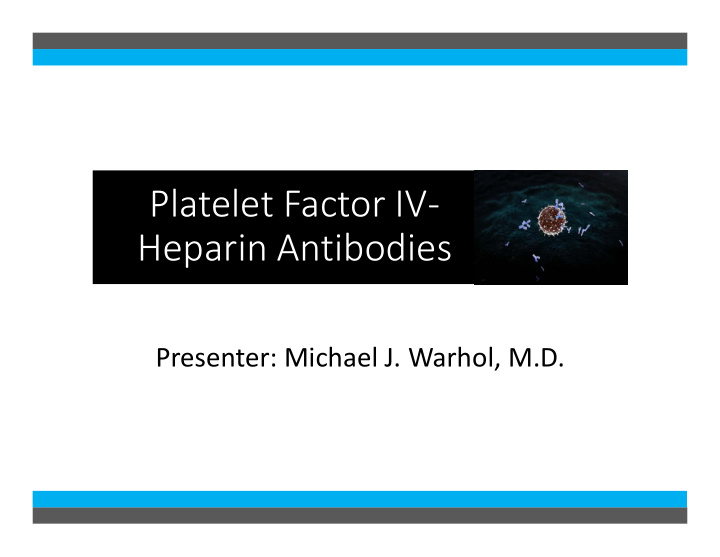



Platelet Factor IV- Heparin Antibodies Presenter: Michael J. Warhol, M.D.
Learning Objectives • Describe the mechanism of interaction between Heparin and Platelet Factor 4 • Review the chemistry of Heparin • Identify the consequences of antibodies to the Heparin Platelet Factor 4 • Examine the testing methodology for the anti-Platelet Factor 4 Heparin anti-body • Enhance the clinical awareness of Platelet Factor IV Antibodies • Population at risk • Clinical signs • Diagnosis and treatment • Importance of protocol • Medical Consequences of Poor Quality • Patient Satisfaction
Extrinsic system Intrinsic system Tissue Damage Surface Contact Tissue Factor XII XIIa XI XI XIa VII VIIa (Xa IX VII VIIa Xa Major Site X V V Major Site a II Iia (Thrombin) Fibrinogen Fibrin
CASE STUDY • 57 year old female admitted with pneumonia and respiratory failure • Admission platelet count was 230,000 • Prophylactic heparin administered • On the 7 th ICU day, the patient arrested • Platelet count 110,000 Result Patient expired Diagnosis-Heparin Induced Thrombocytopenia HIT
Heparin Induced Thrombocytopenia • Most common adverse event with heparin use is bleeding. • Some patients develop a pro-thrombotic state known as heparin induced Thrombocytopenia (HIT) • HIT Type I: Mild asymptomatic decrease in platelet count • HIT Type II: Severe, potentially devastating thromboembolic complication; life and limb threatening
Heparin Induced Thrombocytopenia Type II • An immune complex can form between heparin and platelet Factor 4(PF4) released by platelets. This complex becomes an antigen and elicits an antibody response. • The antibody response destroys the platelets • Observed in 2-5% of patients treated with heparin • The risk of thrombosis is 33-50%
Clinical Signs of HIT • Deep venous thrombosis (50%) • Pulmonary Embolism (25%) • Skin lesions at injection site (10-20%) • Acute limb ischemia (5-10%) • Warfarin associated limb gangrene (5-10%) • Acute CVA or myocardial infarction (3-5%)
Patient Population • Cardiopulmonary Bypass Surgery and Orthopedic Surgery are greatest risks • HIT may also occur through: -Heparin flushes or subcutaneous administration -Heparin-coated catheters and prosthesis -Chronic dialysis patients
Factors Influencing the Frequency of HIT • Type of Heparin and route of administration Bovine UFH>Porcine UFH>LMWH Intravenous>subcutaneous • Patient Population • Duration of heparin therapy-use beyond day 5 increases the risk of HIT • Sex: Female>Male
Probability of HIT • 50% fall in platelet count • Onset between 5 and 10 days after therapy or <1 day if heparin administered within 100 days • New thrombosis or thrombotic signs
The Diagnosis of HIT-The four Ts 1. Thrombocytopenia 2. Timing of Platelet count 3. Thrombosis 4. Other causes of thrombocytopenia
HIT Type II-Clinico-Pathologic Diagnosis • >50% platelet fall from Baseline or <100,000/ml. • Onset varies-typical 5-10 days after heparin exposure; rapid < 1 day of UFH re-exposure (prior exposure within 100 days); delayed-up to 40 days after UFH exposure • New thrombosis, skin necrosis • No other causes • Antibodies to complexes of HPF4
Laboratory Diagnosis of HIT • Platelet Count • H-PF4 antibody check • Platelet Functional Analysis
Antigen-Base Tests • Standardized Reagents • Not dependent on platelet donors • Direct testing for Anti-Platelet Factor IV antibody is available as a stat test with results in 10 minutes
Treatment of HIT • Discontinue heparin • Delay Warfarin until platelet count recovers • Avoid platelet transfusion • Treat with direct thrombin inhibitors, e.g. argantroban(Acova), bivalirudin
Conclusions • HIT is a clinical and laboratory Diagnosis • Patients with HIT are at risk for life and limb threatening thrombotic disease • In critically ill patients, a negative antigen test paired with the 4T’s can exclude the presence of anti-PF4 antibodies
Elisa Vs Immuno Precipitation • Elisa is a two step method versus a one step immuno precipitation method. • Immuno precipitation can be performed in less than one hour.
Recommend
More recommend